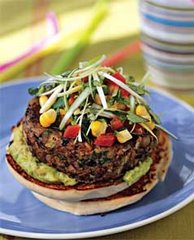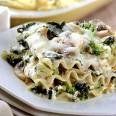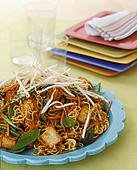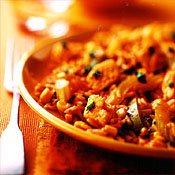My seven year old is a vegetarian. When she started her quest of avoiding meat we thought just cutting out meat itself would be enough, but it has become a journey of shocking, jaw-dropping discovery at just what contains ground-up animal parts. As a result, I am now a veggie. So I have gone from researching good recipes and nutritional information, which is essential for such a young vegetarian, to the family taking on a healthier, more compassionate outlook on life.
Tuesday, 3 April 2007
Blessed are the cheese makers........
In my own merry, yet naive way, I thought that cheese was ok, no animal had been harmed in the making of my cheese. Until I started looking a little deeper at what lies within and discovered rennet (or rennin).
I genuinely thought cheese was made from milk that had been jiggled about a bit in a vat, left to go smelly or hard, or both, depending on the variety.
Nowhere did a slaughtered calf gut come into the equation.
Traditionally, the first step in making cheese was to kill a newly-born, milk-fed calf and remove its stomach to make rennet. The rennet was derived from the inner lining of the abomasum, the fourth stomach of the calf or any other animal classified as a ruminant (cud-chewing mammal and a stomach with multiple chambers).
Rennet is defined on ‘Wikipedia, (http://en.wikipedia.org/wiki/Rennet) the online dictionary,’ “as a natural complex of enzymes produced in any mammalian stomach to digest the mother's milk. Rennet contains an enzyme that coagulates the milk, causing it to separate into solids (curds) and liquid (whey). The active enzyme in rennet is called rennin or chymosin.
According to the ‘Vegetarians in Paradise’ website, after scraping, soaking in cold water and thoroughly washing the stomach, the cheese maker would dry it in the sun by stretching it on a rack. After the stomach was dry, it was cut into squares or strips, before being placed in milk.
In an alternative process the strips or squares were dried, then ground, and finally mixed with a salt solution, for several days, to extract rennet.
What does rennet do?
Placed in milk, rennet breaks down a protein called kappa casein that keeps milk in liquid form. The breaking down of kappa casein leads to coagulation of the milk that will become cheese.
Not all cheese is made with animal-derived rennet. Rennet-less has become the generic term for any cheese made without any animal derived enzymes, there are a number of rennet-less cheeses whose coagulating enzymes are vegetable, microbial, or genetically engineered.
Vegetable rennet usually means the enzyme was plant based, although the phrase is an oxymoron because rennet implies it is animal derived. In the past, cheese makers have utilized plants like lady's bedstraw (Galium verum or curdwort), stinging nettle, fig leaves, melon, safflower, and wild thistle.
Microbial rennet can be produced by fermentation of the fungus Mucor miehe, Mucor Pusillus, and Endothia cryphonectria or from bacteria like Bacillus subililis or Bacillus prodigiosum. This type of rennet cannot be used to make cheddar or hard cheeses.
Genetically engineered rennet. Supply problems have led to all types of research, including one attempt in 1997 to create rennet from fish stomach mucosa, a waste product of the fishing industry.
The bioengineering process involves taking a calf's prochymosin gene and inserting it into genomes of bacteria and yeast. According to ‘Wikipedia’ the microbial chymosin was the first artificially produced enzyme to be registered and allowed by the FDA in the USA. In 1999, about 60% of U.S. hard cheese was made with genetically engineered Chymosin.
The producers of bioengineered rennet claim that their process will end the cheese industry's reliance on slaughtered calves, as there is an endless supply and it is less expensive.
It all sounds so confusing!
It does depend on the cheese, as cottage, ricotta and some varieties of mozzarella cheeses have acidic levels high enough not to require enzymes for coagulation, so these are naturally vegetarian, but check the labelling!
As for a vegetarian hard cheese, according to the Vegetarian Society the majority of cheese suitable for vegetarians is made using an enzyme developed with the use of biotechnology. This enzyme is used in replacement of traditional rennet, and is produced using proven technology under controlled conditions with no environmental, animal welfare or human health implications. (http://www.vegsoc.org/info/cheese.html)
So although rennet is available in synthesized form it is not safe to assume it has been used, and just to be on the safe side make sure the green ‘V’ for vegetarian is on the label.
I genuinely thought cheese was made from milk that had been jiggled about a bit in a vat, left to go smelly or hard, or both, depending on the variety.
Nowhere did a slaughtered calf gut come into the equation.
Traditionally, the first step in making cheese was to kill a newly-born, milk-fed calf and remove its stomach to make rennet. The rennet was derived from the inner lining of the abomasum, the fourth stomach of the calf or any other animal classified as a ruminant (cud-chewing mammal and a stomach with multiple chambers).
Rennet is defined on ‘Wikipedia, (http://en.wikipedia.org/wiki/Rennet) the online dictionary,’ “as a natural complex of enzymes produced in any mammalian stomach to digest the mother's milk. Rennet contains an enzyme that coagulates the milk, causing it to separate into solids (curds) and liquid (whey). The active enzyme in rennet is called rennin or chymosin.
According to the ‘Vegetarians in Paradise’ website, after scraping, soaking in cold water and thoroughly washing the stomach, the cheese maker would dry it in the sun by stretching it on a rack. After the stomach was dry, it was cut into squares or strips, before being placed in milk.
In an alternative process the strips or squares were dried, then ground, and finally mixed with a salt solution, for several days, to extract rennet.
What does rennet do?
Placed in milk, rennet breaks down a protein called kappa casein that keeps milk in liquid form. The breaking down of kappa casein leads to coagulation of the milk that will become cheese.
Not all cheese is made with animal-derived rennet. Rennet-less has become the generic term for any cheese made without any animal derived enzymes, there are a number of rennet-less cheeses whose coagulating enzymes are vegetable, microbial, or genetically engineered.
Vegetable rennet usually means the enzyme was plant based, although the phrase is an oxymoron because rennet implies it is animal derived. In the past, cheese makers have utilized plants like lady's bedstraw (Galium verum or curdwort), stinging nettle, fig leaves, melon, safflower, and wild thistle.
Microbial rennet can be produced by fermentation of the fungus Mucor miehe, Mucor Pusillus, and Endothia cryphonectria or from bacteria like Bacillus subililis or Bacillus prodigiosum. This type of rennet cannot be used to make cheddar or hard cheeses.
Genetically engineered rennet. Supply problems have led to all types of research, including one attempt in 1997 to create rennet from fish stomach mucosa, a waste product of the fishing industry.
The bioengineering process involves taking a calf's prochymosin gene and inserting it into genomes of bacteria and yeast. According to ‘Wikipedia’ the microbial chymosin was the first artificially produced enzyme to be registered and allowed by the FDA in the USA. In 1999, about 60% of U.S. hard cheese was made with genetically engineered Chymosin.
The producers of bioengineered rennet claim that their process will end the cheese industry's reliance on slaughtered calves, as there is an endless supply and it is less expensive.
It all sounds so confusing!
It does depend on the cheese, as cottage, ricotta and some varieties of mozzarella cheeses have acidic levels high enough not to require enzymes for coagulation, so these are naturally vegetarian, but check the labelling!
As for a vegetarian hard cheese, according to the Vegetarian Society the majority of cheese suitable for vegetarians is made using an enzyme developed with the use of biotechnology. This enzyme is used in replacement of traditional rennet, and is produced using proven technology under controlled conditions with no environmental, animal welfare or human health implications. (http://www.vegsoc.org/info/cheese.html)
So although rennet is available in synthesized form it is not safe to assume it has been used, and just to be on the safe side make sure the green ‘V’ for vegetarian is on the label.
Subscribe to:
Post Comments (Atom)
































No comments:
Post a Comment